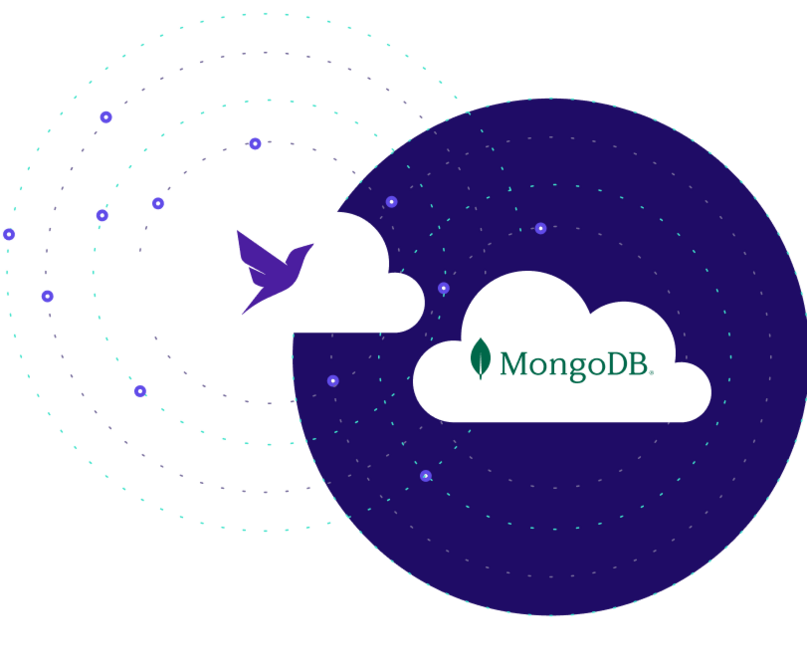Fauna
vs MongoDB
Why customers choose Fauna’s Document Relational-Database over MongoDB


Key Differentiators
Why application teams choose Fauna over MongoDB

Infrastructure & Scaling Simplicity
Eliminate the undifferentiated operational overhead associated with building and scaling your database.

Data Model and Querying Power
Add the power of relations to a distributed document database.

Modern & Scalable Connectivity
Simplify application architectures with Fauna’s HTTPS API delivery model.

Advanced Security
Elevate data protection with user-grained, dynamic, and real-time access control.

Administration & Deployment
MongoDB Atlas
Traditional node-based architecture. Single compute layer. Nuanced CPU to memory sizing. Relies on local storage or memory caching for IO performance.

MongoDB Atlas
Serverless. No ops. All features natively available, over multi-region, with consistency. Scale-ready & configuration-free serverless.
Traditional node-based architecture. Single compute layer. Nuanced CPU to memory sizing. Relies on local storage or memory caching for IO performance.
MongoDB Atlas
Administration & Deployment

Use Cases Where Fauna Out-Performs Mongo
Fauna excels in environments where modern application requirements demand flexibility, scalability, and cost optimization.
Applications Requiring Document Storage with Relational Access Patterns
Fauna stores data as JSON documents, but maintains native relational features like joins and schema enforcement, making it perfect for applications storing different shapes of data with sophisticated access patterns. MongoDB struggles with these use cases due to its lack of native joins, schema enforcement, and reliance on pre-compiled views or embedded patterns.


Applications with Changing Access Patterns
Fauna’s document-relational model is ideal for applications where access patterns evolve over time. With native support for relations, Fauna enables developers to adjust data models and queries without having to re-architect or denormalize the data, providing unparalleled flexibility for complex applications. MongoDB, on the other hand, relies heavily on fixed access patterns and embedded schemas, making changes more costly and difficult to manage.
Applications with Serverless or API-driven Architectures
Fauna’s fully serverless model is delivered as an HTTPS API and scales effortlessly for serverless and edge applications, with no need for connection pooling or complex middleware. In contrast, MongoDB’s node-based architecture introduces scaling limitations and operational overhead for serverless environments. MongoDB announced the deprecation of its Data API, limiting native connectivity options for these architectures.


Applications with Multi-region or Edge Workloads
With Fauna’s native multi-active architecture, it's designed for apps that need low-latency, strongly consistent reads and writes across multi-region locations. MongoDB, especially Atlas, requires more complex configurations for multi-region support, manual sharding, and sacrifices consistency for performance.
Applications with Multi-tenant Workloads
Fauna’s multi-tenant architecture simplifies building secure, tenant-isolated apps with dynamic ABAC (attribute-based access control). MongoDB lacks this out-of-the-box, often requiring custom engineering and third-party tools for multi-tenancy and fine-grained access control.

Fauna vs Atlas
Organizations choose Fauna over MongoDB Atlas because it combines the relational qualities of joins, and schema enforcement, and ACID transactions with the flexibility of a document database, delivered as a fully serverless cloud API – ensuring seamless scalability and zero operational overhead.

Administration & Deployment
MongoDB Atlas
Hosted. Skill, effort, & resources required to design and manage clusters (sizes, configurations & features to achieve performance/costs).

Serverless. No ops. All features natively available, over multi-region, with consistency. Scale-ready & configuration-free serverless.
MongoDB Atlas
Administration & Deployment

Engine
MongoDB Atlas
Traditional node-based architecture. Single compute layer. Nuanced CPU to memory sizing. Relies on local storage or memory caching for IO performance.

Next generation distributed architecture. Fauna’s Distributed Transaction Engine (DTE) allows for optimal scaling, resource efficiency & performance without engineering resources.
MongoDB Atlas
Administration & Deployment

Cluster Scaling
MongoDB Atlas
Vertical with manual horizontal scaling. Requires complex sharding strategy.

Horizontal scaling. Auto-provisioned with no sharding.
MongoDB Atlas
Administration & Deployment

Auto-Scaling
MongoDB Atlas
Hourly.

On-demand.
MongoDB Atlas
Administration & Deployment

Replication Model
MongoDB Atlas
Native single-region clusters require add-on features and architectural configuration & planning for multi-region deployments & failover.

Auto-replication across three locations.
MongoDB Atlas
Administration & Deployment

Resiliency & Availability
MongoDB Atlas
Native single-region clusters require add-on features and architectural configuration & planning for multi-region deployments & failover.

Native multi-region w/ active-active reads & writes, auto-routing, & strong consistency for automatic availability & resilience.
MongoDB Atlas
Administration & Deployment

Data Model
MongoDB Atlas
Document. No native joins. Strongly recommends utilizing “embedded” patterns and avoiding normalization.

Document-relational. Data stored in JSON documents with native joins and full relational support. Embed or normalize - providing optionality for any schema model or access pattern.
MongoDB Atlas
Administration & Deployment

Schema Support
MongoDB Atlas
Schema validation. Limited options for data validation. Schema applied at write-time.

Schema enforcement. Evolve schema and enforce constraints as applications mature and scale. Constraints, computed fields, & type enforcement for full control.
MongoDB Atlas
Administration & Deployment

Consistency Model
MongoDB Atlas
Traditional node-based architecture. Single compute layer. Nuanced CPU to memory sizing. Relies on local storage or memory caching for IO performance.

Serverless. No ops. All features natively available, over multi-region, with consistency. Scale-ready & configuration-free serverless.
MongoDB Atlas
Administration & Deployment

Tenancy
MongoDB Atlas
Native single-tenant. Significant effort required to design scalable, efficient, and secure multi-tenant system.

Native multi-tenant. Databases as logical containers. No limit in number. Instantly available. API delivery with tokens simplifies scoped permissions.
MongoDB Atlas
Administration & Deployment

Connectivity
MongoDB Atlas
Session-pooling. Stateful sessions requiring sized pools.

HTTPS API. Stateless & sessionless for secure & scalable connectivity.
MongoDB Atlas
Administration & Deployment

Authentication
MongoDB Atlas
Traditional account-based. Static, long-lived security contexts with limited access.

Token-based. Ability to enforce identity-based authorization.
MongoDB Atlas
Administration & Deployment

Authentication
MongoDB Atlas
Traditional account-based. Static, long-lived security contexts with limited access

Token-based. Ability to enforce identity-based authorization.
MongoDB Atlas
Administration & Deployment

Engine
MongoDB Atlas
Traditional node-based architecture. Single compute layer. Nuanced CPU to memory sizing. Relies on local storage or memory caching for IO performance.

MongoDB Atlas
Next generation distributed architecture. Fauna’s Distributed Transaction Engine (DTE) allows for optimal scaling, resource efficiency & performance without engineering resources.
Traditional node-based architecture. Single compute layer. Nuanced CPU to memory sizing. Relies on local storage or memory caching for IO performance.
MongoDB Atlas
Administration & Deployment

Cluster Scaling
MongoDB Atlas
Vertical with manual horizontal scaling. Requires complex sharding strategy.

MongoDB Atlas
Horizontal scaling. Auto-provisioned with no sharding.
Traditional node-based architecture. Single compute layer. Nuanced CPU to memory sizing. Relies on local storage or memory caching for IO performance.
MongoDB Atlas
Administration & Deployment

Auto-Scaling
MongoDB Atlas
Hourly.

MongoDB Atlas
On-demand.
Traditional node-based architecture. Single compute layer. Nuanced CPU to memory sizing. Relies on local storage or memory caching for IO performance.
MongoDB Atlas
Administration & Deployment

Replication Model
MongoDB Atlas
Native single-region clusters require add-on features and architectural configuration & planning for multi-region deployments & failover.

MongoDB Atlas
Auto-replication across three locations.
Traditional node-based architecture. Single compute layer. Nuanced CPU to memory sizing. Relies on local storage or memory caching for IO performance.
MongoDB Atlas
Administration & Deployment

Resiliency & Availability
MongoDB Atlas
Native single-region clusters require add-on features and architectural configuration & planning for multi-region deployments & failover.

MongoDB Atlas
Native multi-region w/ active-active reads & writes, auto-routing, & strong consistency for automatic availability & resilience.
Traditional node-based architecture. Single compute layer. Nuanced CPU to memory sizing. Relies on local storage or memory caching for IO performance.
MongoDB Atlas
Administration & Deployment

Data Model
MongoDB Atlas
Document. No native joins. Strongly recommends utilizing “embedded” patterns and avoiding normalization.

MongoDB Atlas
Document-relational. Data stored in JSON documents with native joins and full relational support. Embed or normalize - providing optionality for any schema model or access pattern.
Traditional node-based architecture. Single compute layer. Nuanced CPU to memory sizing. Relies on local storage or memory caching for IO performance.
MongoDB Atlas
Administration & Deployment

Schema Support
MongoDB Atlas
Schema validation. Limited options for data validation. Schema applied at write-time.

MongoDB Atlas
Schema enforcement. Evolve schema and enforce constraints as applications mature and scale. Constraints, computed fields, & type enforcement for full control.
Traditional node-based architecture. Single compute layer. Nuanced CPU to memory sizing. Relies on local storage or memory caching for IO performance.
MongoDB Atlas
Administration & Deployment

Consistency Model
MongoDB Atlas
Schema validation. Limited options for data validation. Schema applied at write-time

MongoDB Atlas
Schema enforcement. Evolve schema and enforce constraints as applications mature and scale. Constraints, computed fields, & type enforcement for full control.
Traditional node-based architecture. Single compute layer. Nuanced CPU to memory sizing. Relies on local storage or memory caching for IO performance.
MongoDB Atlas
Administration & Deployment

Consistency Model
MongoDB Atlas
Eventually consistent by default. Strong consistency comes with performance impact and design challenges.

MongoDB Atlas
Strictly serializable; strongest level of consistency by default across regions, without performance concessions.
Traditional node-based architecture. Single compute layer. Nuanced CPU to memory sizing. Relies on local storage or memory caching for IO performance.
MongoDB Atlas
Administration & Deployment

Tenancy
MongoDB Atlas
Native single-tenant. Significant effort required to design scalable, efficient, and secure multi-tenant system.

MongoDB Atlas
Native multi-tenant. Databases as logical containers. No limit in number. Instantly available. API delivery with tokens simplifies scoped permissions.
Traditional node-based architecture. Single compute layer. Nuanced CPU to memory sizing. Relies on local storage or memory caching for IO performance.
MongoDB Atlas
Administration & Deployment

Connectivity
MongoDB Atlas
Session-pooling. Stateful sessions requiring sized pools.

MongoDB Atlas
HTTPS API. Stateless & sessionless for secure & scalable connectivity.
Traditional node-based architecture. Single compute layer. Nuanced CPU to memory sizing. Relies on local storage or memory caching for IO performance.
MongoDB Atlas
Administration & Deployment

Authentication
MongoDB Atlas
Traditional account-based. Static, long-lived security contexts with limited access.

MongoDB Atlas
Token-based. Ability to enforce identity-based authorization.
Traditional node-based architecture. Single compute layer. Nuanced CPU to memory sizing. Relies on local storage or memory caching for IO performance.
MongoDB Atlas
Administration & Deployment

Administration & Deployment
MongoDB Atlas
Traditional node-based architecture. Single compute layer. Nuanced CPU to memory sizing. Relies on local storage or memory caching for IO performance.

MongoDB Atlas
Serverless. No ops. All features natively available, over multi-region, with consistency. Scale-ready & configuration-free serverless.
Traditional node-based architecture. Single compute layer. Nuanced CPU to memory sizing. Relies on local storage or memory caching for IO performance.
MongoDB Atlas
Administration & Deployment

Administration & Deployment
MongoDB Atlas
Traditional node-based architecture. Single compute layer. Nuanced CPU to memory sizing. Relies on local storage or memory caching for IO performance.

MongoDB Atlas
Serverless. No ops. All features natively available, over multi-region, with consistency. Scale-ready & configuration-free serverless.
Traditional node-based architecture. Single compute layer. Nuanced CPU to memory sizing. Relies on local storage or memory caching for IO performance.
MongoDB Atlas
Administration & Deployment
MongoDB Atlas




Administration & Deployment
Hosted. Skill, effort, & resources required to design and manage clusters (sizes, configurations & features to achieve performance/costs).
Serverless. No ops. All features natively available, over multi-region, with consistency. Scale-ready & configuration-free serverless.

Engine
Traditional node-based architecture. Single compute layer. Nuanced CPU to memory sizing. Relies on local storage or memory caching for IO performance.
Next generation distributed architecture. Fauna’s Distributed Transaction Engine (DTE) allows for optimal scaling, resource efficiency & performance without engineering resources.

Cluster Scaling
Vertical with manual horizontal scaling. Requires complex sharding strategy.
Horizontal scaling. Auto-provisioned with no sharding.

Auto-Scaling
Hourly.
On-demand.

Replication Model
Native single-region clusters require add-on features and architectural configuration & planning for multi-region deployments & failover.
Auto-replication across three locations.

Resiliency & Availability
Native single-region clusters require add-on features and architectural configuration & planning for multi-region deployments & failover.
Native multi-region w/ active-active reads & writes, auto-routing, & strong consistency for automatic availability & resilience.

Data Model
Document. No native joins. Strongly recommends utilizing “embedded” patterns and avoiding normalization.
Document-relational. Data stored in JSON documents with native joins and full relational support. Embed or normalize - providing optionality for any schema model or access pattern.

Schema Support
Schema validation. Limited options for data validation. Schema applied at write-time.
Schema enforcement. Evolve schema and enforce constraints as applications mature and scale. Constraints, computed fields, & type enforcement for full control.

Consistency Model
Eventually consistent by default. Strong consistency comes with performance impact and design challenges.
Strictly serializable; strongest level of consistency by default across regions, without performance concessions.

Tenancy
Native single-tenant. Significant effort required to design scalable, efficient, and secure multi-tenant system.
Native multi-tenant. Databases as logical containers. No limit in number. Instantly available. API delivery with tokens simplifies scoped permissions.

Connectivity
Session-pooling. Stateful sessions requiring sized pools.
HTTPS API. Stateless & sessionless for secure & scalable connectivity.

Authentication
Traditional account-based. Static, long-lived security contexts with limited access.
Token-based. Ability to enforce identity-based authorization.
Fauna vs Atlas Serverless
Fauna's automatic scaling, data model flexibility, and global distribution provides a robust and flexible solution that outperforms the limited Atlas Serverless offering.

Scale
MongoDB Atlas
Optimized for small & simple use cases. Atlas Serverless does not support multi-region deployments, multi-cloud deployments, sharded deployments, global clusters, triggers, Atlas Search, and a variety of aggregation pipeline functions.

Fully available, at-scale. Natively serverless. Multi-region, strongly consistent and low latency with joins, change streams out of the box.
MongoDB Atlas
Administration & Deployment

Features
MongoDB Atlas
Limited. Many Atlas (dedicated cluster) features unavailable, or come with strict limits. i.e. Connection pool size, DB count, no Global Clusters or Sharding or multi-region, data < 1TB, no change streams, max 50 databases, max 500 connections, etc.

Production ready out of the box for sophisticated use cases. Multi-region replication, strong consistency, full relational capabilities, auto-routing and low latency – all delivered as an API.
MongoDB Atlas
Administration & Deployment

Cost profile
MongoDB Atlas
Expensive to scale. Node-based cluster model passes along costs, with premium applied, for maintaining under-utilized resources.

Optimized for scale. Large multi-tenant cluster enables optimal resource allocation, eliminating over-provisioning.
MongoDB Atlas
Administration & Deployment

Connectivity
MongoDB Atlas
Connection pool based. Mandates architectural considerations between front and back end. Incompatible with modern, API-first architectures.

API delivery based. Unlimited scale, direct access (no middleware), simplified architecture, auto-routing, lowest geographical latency. Great for edge or serverless use cases.
MongoDB Atlas
Administration & Deployment

Authentication
MongoDB Atlas
Traditional account-based. Static, long-lived security contexts with limited access

Token-based. Ability to enforce identity-based authorization.
MongoDB Atlas
Administration & Deployment
Administration & Deployment
MongoDB Atlas
MongoDB Atlas
Traditional node-based architecture. Single compute layer. Nuanced CPU to memory sizing. Relies on local storage or memory caching for IO performance.

Serverless. No ops. All features natively available, over multi-region, with consistency. Scale-ready & configuration-free serverless.
Administration & Deployment
Atlas Serverless




Scale
Limited. Many Atlas (dedicated cluster) features unavailable, or come with strict limits. i.e. Connection pool size, DB count, no Global Clusters or Sharding or multi-region, data < 1TB, no change streams, max 50 databases, max 500 connections, etc.
Fully available, at-scale. Natively serverless. Multi-region, strongly consistent and low latency with joins, change streams out of the box.

Features
Optimized for small & simple use cases. Atlas Serverless does not support multi-region deployments, multi-cloud deployments, sharded deployments, global clusters, triggers, Atlas Search, and a variety of aggregation pipeline functions.
Production ready out of the box for sophisticated use cases. Multi-region replication, strong consistency, full relational capabilities, auto-routing and low latency – all delivered as an API.

Cost profile
Expensive to scale. Node-based cluster model passes along costs, with premium applied, for maintaining under-utilized resources.
Optimized for scale. Large multi-tenant cluster enables optimal resource allocation, eliminating over-provisioning.

Connectivity
Connection pool based. Mandates architectural considerations between front and back end. Incompatible with modern, API-first architectures.
API delivery based. Unlimited scale, direct access (no middleware), simplified architecture, auto-routing, lowest geographical latency. Great for edge or serverless use cases.

Get started building with Fauna
Explore resources that can help get you up and running in minutes.
Multi-tenant SaaS Sample App
Learn how to build a multi-tenant, multi-region SaaS app without ops using Fauna and AWS
BUILD THE SAMPLE APP
New to Fauna Query Language?
This guide can help you get started with FQL in under 10 minutes.
READ MORE
Workshops
Learn how to build complete applications using technology like AWS, Cloudflare, and more.
EXPLORE THE WORKSHOPS
FAQs
Have other questions? Feel free to contact us, or browse our documentation.

Traditional node-based architecture. Single compute layer. Nuanced CPU to memory sizing. Relies on local storage or memory caching for IO performance.